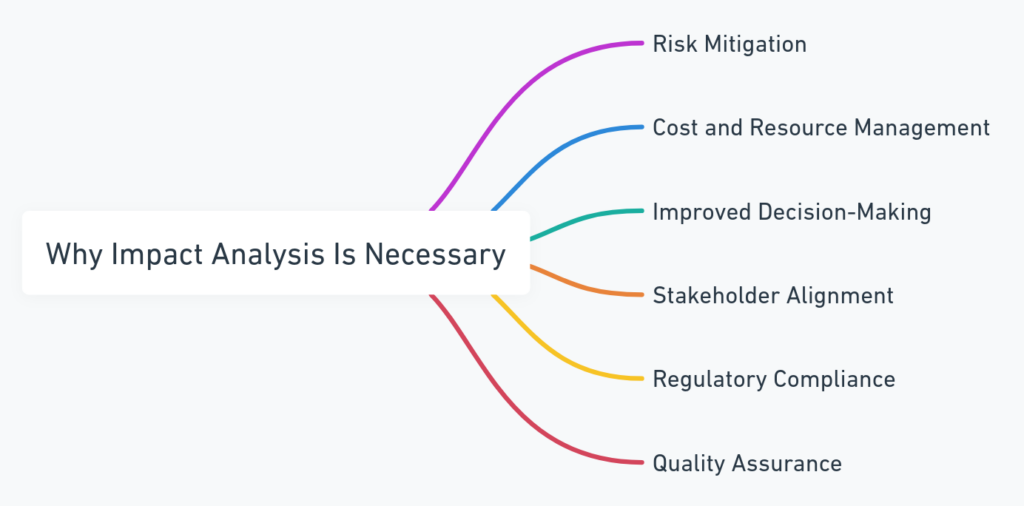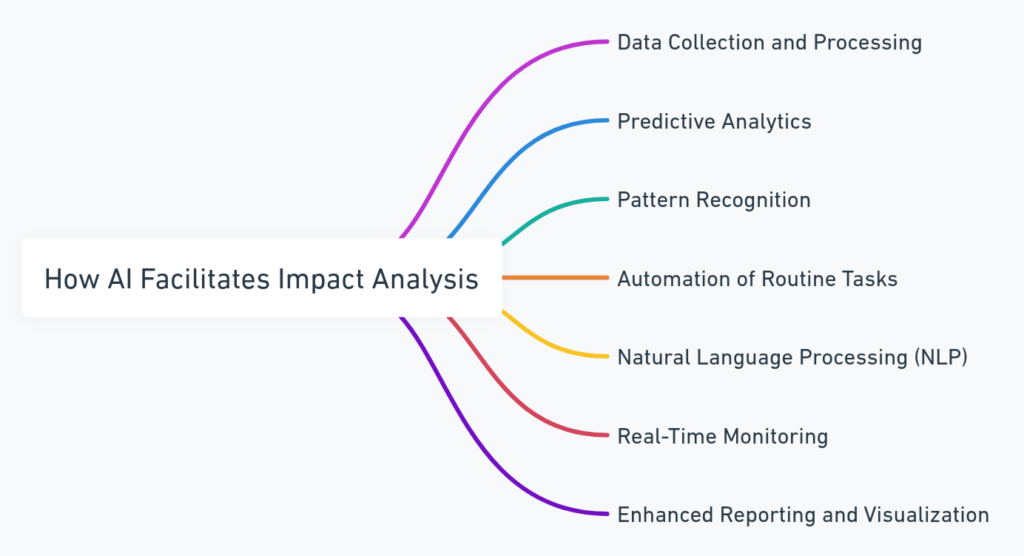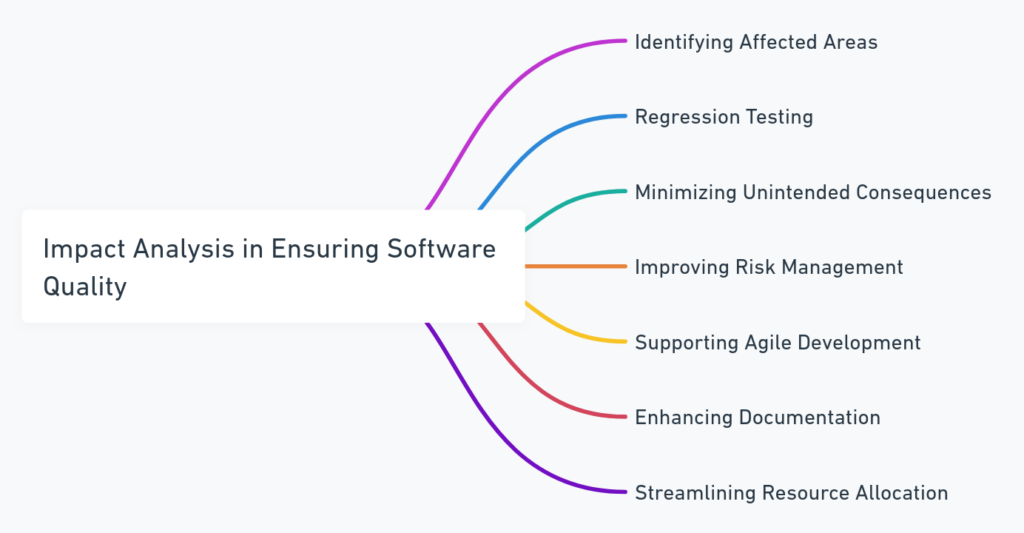At an increasingly rapid software development pace, keeping pace with frequent code changes while simultaneously producing quality releases is a difficult challenge.
Each code update may impact different areas of an app; therefore understanding their effects upon overall system functionality and bugs are vitally important if new bugs or breaking functionalities occur - this is where impact analysis comes into play.
In this blog post, we'll look into the significance of conducting impact analysis during software testing; how AI-powered solutions make this step more efficient; and why this essential process ensures long-term software quality.
Understanding Impact Analysis
Impact analysis refers to identifying and assessing the potential repercussions of changes made to a system's code. It involves tracking their ripple effects to ascertain which parts of an application could be affected and what could go wrong without proper testing.
Impact analysis seeks to answer a key question about code modifications: what could possibly go wrong if we make changes here?
By understanding which areas require further attention and potential problem areas they can focus their testing efforts accordingly.
Why Is Impact Analysis Necessary?

- Reducing Risk: Any time changes to complex systems occur, there can be the possibility of unintended impacts to other areas if certain risks go undetected and ignored until later addressed in production code. Impact analysis helps identify these points so any vulnerabilities are addressed prior to production pushout.
- Prioritization: Not all changes require equal testing effort; using impact analysis allows teams to quickly prioritize high-risk areas that might become susceptible to breaks due to new code modifications.
- Increase Efficiency: Without impact analysis, testers might waste their time running tests that don't pertain to code changes. By targeting those areas that really matter during impact testing, impact analysis helps streamline testing procedures while saving both time and resources in testing processes.
- Prevention: Regressions occur when new changes unintentionally break previously working functionality, so impact analysis ensures code updates don't trigger regressions in critical workflows.
How AI Facilitates Impact Analysis

Traditional impact analysis relies heavily on manual effort from developers and testers who must carefully inspect code dependencies and potential risk areas before conducting impact analyses manually.
With large applications this can become laborious, time consuming and error prone; AI-powered impact analyses offer a reliable alternative solution.
AI tools offer automated code review capabilities with real-time insight into potential impacts to an entire system. Here's how AI improves impact analysis:
1. Automated Assessments of Code Changes
AI tools can analyze codebases to detect recent modifications that are most likely to have an effect.
They look for dependencies between modules as well as historical test results in order to better assess which parts of an app could possibly be impacted by those modifications.
- Speed: AI can scan thousands of lines of code in seconds, providing rapid assessments of potential risk areas.
- Precision: By considering historical test data and code dependencies, AI delivers accurate and targeted impact analysis, helping teams focus on the right areas.
2. Predictive Modeling
AI-powered impact analysis tools can predict how likely changes are to cause failure based on historical patterns and past test results.
For instance, if an identical code change led to failure before in a particular module, AI systems might flag that module as potentially risky and suggest additional testing of that area.
- Learning from Past Data: By utilizing machine learning algorithms, AI systems can continuously improve their predictions based on past experiences.
- Actionable Insights: Predictive modeling offers actionable insights for teams, allowing them to proactively address risk areas before they lead to problems in production.
3. Intelligent Test Prioritization
One of the primary challenges in software testing is choosing which tests to run after making code modifications.
With limited resources and time available to us all, running all available tests every time would not be efficient or beneficial; AI tools provide an efficient alternative allowing prioritized execution based on scope/nature changes to run only those necessary tests at that moment in time.
- Intelligent Test Selection: AI tools can recommend which tests should run based on which areas may be most affected by code changes, ensuring no essential tests are missed out.
- Adaptive Learning: Over time, AI systems adapt their recommendations based on past test results; continually refining them for subsequent exams.
4. Real-Time Feedback
AI-powered impact analysis tools offer real-time feedback on how a code change impacts a system, enabling developers and testers to respond promptly if an issue arises; should any problems arise, flagging software immediately reduces time spent diagnosing problems.
- Continuous Monitoring: AI tools continuously monitor systems during and after code changes to identify any potential issues at an early stage and minimize delays caused by costly delays.
- Early Detection: Real-time feedback enables early identification and fixing of problems more rapidly thereby decreasing risks posed by costly delays.
Impact Analysis in Ensuring Software Quality

Impact analysis's primary aim is to preserve and enhance software quality; here's why impact analysis plays such an essential role:
1. Reduces Bugs and Defects
Conducting impact analysis helps eliminate bugs introduced through code changes by identifying areas most impacted.
By doing this, more users experience greater product satisfaction with reduced bugs being introduced resulting in overall superiority of quality of results.
2. Increased Release Confidence
When teams conduct rigorous impact analyses, they can release new code with confidence that all potential risk areas have been thoroughly explored and tested, thus decreasing post-release issues while building trust between all participants in the development process.
3. Facilitates Collaboration Between Teams
AI-powered impact analysis can facilitate cooperation among developers and testers by offering clear views into risk areas, offering actionable insights that enable both sides of a partnership to address potential problems quickly and efficiently.
4. Facilitates Agile and Continuous Delivery
In agile development environments, frequent code releases and revisions are the norm.
AI-powered impact analysis assists this practice by offering real-time evaluation of code changes that enable teams to respond rapidly in response to potential risks - thus helping ensure an efficient software development lifecycle process.
Book a Demo and experience ContextQA testing tool in action with a complimentary, no-obligation session tailored to your business needs.
Conclusion
Conducting impact analyses is an integral component to maintaining software quality as development cycles become shorter and more frequent.
By identifying any associated risk, impact analyses enable teams to target their testing efforts where it really counts - thus decreasing chances of bugs or regressions occurring during software testing processes.
Artificial Intelligence-powered impact analysis has revolutionized this process. Automated assessments, intelligent test prioritization and real-time feedback allow teams to confidently manage code changes while upholding quality standards.
Organizations using AI-powered impact analysis can benefit by adopting AI into their testing processes, shortening time to market, and producing top-of-the-line software that exceeds user expectations.
Also Read - Challenges in Software Testing and How to Overcome Them
We make it easy to get started with the ContextQA tool: Start Free Trial.
